

 The Accurate Reloading Forums
The Accurate Reloading Forums  THE ACCURATE RELOADING.COM FORUMS
THE ACCURATE RELOADING.COM FORUMS  Other Topics
Other Topics  Recipes for Hunters
Recipes for Hunters  Brooklyn Brewshop's Dandelion Gruit
Brooklyn Brewshop's Dandelion GruitGo  | New  | Find  | Notify  | Tools  | Reply  |  |
| one of us |
Today, I brewed a Dandelion Gruit, from Brooklyn Brew Shop.  As usual, I'll start with the particulars: Informational link: http://brooklynbrewshop.com/be.../dandelion-gruit-mix Instructions: http://brooklynbrewshop.com/di...uit_Instructions.pdf Gruit is an ancient style of beer that was in wide use before hops became popular. In gruits, herbs, spices and other flavourings were used as bittering agents to balance the malts. You can read more about gruit here: https://en.wikipedia.org/wiki/Gruit With this gruit, dandelion leaves fill the role of bittering agent, along with lemon peel and black peppercorns. I decided to get a little creative, and added a few other things. After brewing this, I think we've got something interesting here, in a good way. I made this from a pre-packaged mix, but I also have the recipe for this gruit from Brooklyn Brewshop's book, MAKE SOME BEER. The closest homebrew supply store is 250 miles away, so it's easier for me to just to get the mixes sometimes, rather than trying to assemble the ingredients myself. I highly recommend this book, along with their first book, BEER BREWING BOOK. Both books have dozens of creative and interesting recipes, each written for 1 or 5 gallons. If anyone would like to try this recipe, shoot me a PM and I can send it over via email (it's in pdf format). With dandelions in full swing, now's the time! It started out as a pretty standard brew. The mash went well for the most part with only a little bit of trouble holding temperatures in the ideal range. I was above my range for a couple of minutes, but hopefully this did not adversely affect the beer too much. My past experience tells me that everything will be fine, as far as that goes. Interesting note - these grains (and the wort they produced) seemed to have a bit of lemony quality to them, without any additives. Looking at the grains in the recipe (Belgian Pilsner and White Wheat), I'm not sure why, but it is quite pleasant. The boil is where things went out of the box, literally. Gruits balance the sweet malts with herbs and spices rather than hops, and Medieval monks were quite creative in their variations. The original recipe for this gruit calls simply for dandelion leaves, black peppercorns and lemon peel, but I had a hard time simply leaving it at that, and decided to add a few other additions that would have been available to abbey breweries. I looked through my inventory and found all kinds of things. One thing I was missing was whole cloves, but there were quite a few other interesting alternatives, and I put together what I hope turns out to be a good blend. I did some searching on the Internet, gathered some ideas, and converted some usages from 5 gallons down to 1 gallon. Wanting to take a rather conservative approach to my radical addition of stuff, I smelled/tasted the herbs and spices and decided to go with these amounts for this first brew: For the 60-minute boil: *7 dandelion leaves (beginning of boil) 1 cinnamon stick (beginning of boil) *Black peppercorns - 5g (45 minutes left in boil) Long pepper - 5g (45 minutes left in boil) *1 lemon peel Grains of paradise - 0.4g (10 minutes left in boil) Coriander seed - 1g (10 minutes left in boil) Allspice berries - 1g (10 minutes left in boil) Mugwort - 5g (5 minutes left in boil) Elderflowers - 5g (5 minutes left in boil) *Called for in original recipe (twice as many black peppercorns used in original recipe) I did take a few photos with this brew. I apologise for the cell phone pictures, but we haven't gotten a new camera yet. Here are the dandelion leaves, lemon and black peppercorns (I cut the amount of peppercorns in half in order to use the long pepper: 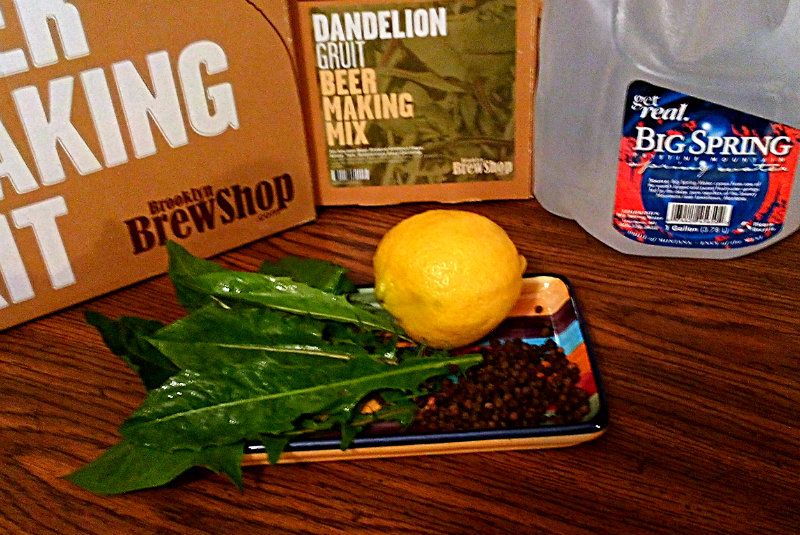 Here is the cinnamon stick along with the lemon peel: 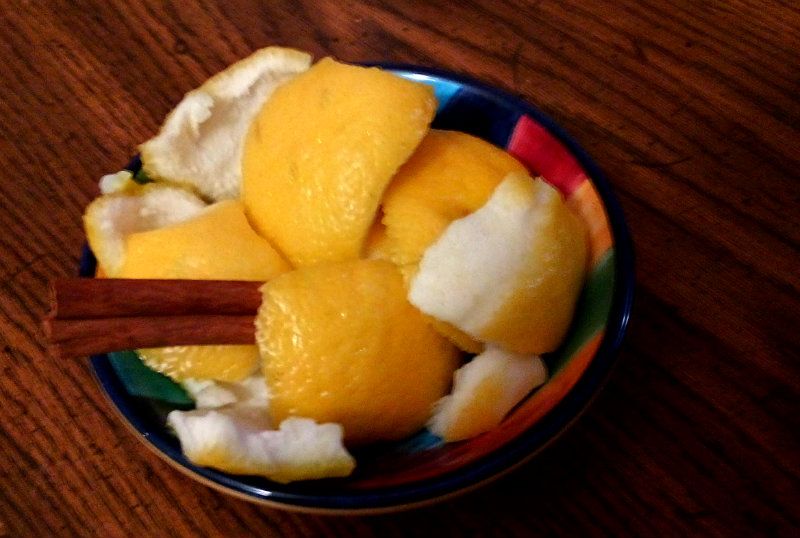 The dandelion leaves and cinnamon stick were added at the beginning of the boil. The lemon peel was added with 10 minutes left in the boil. Here are half the black peppercorns with an equal amount of long pepper: 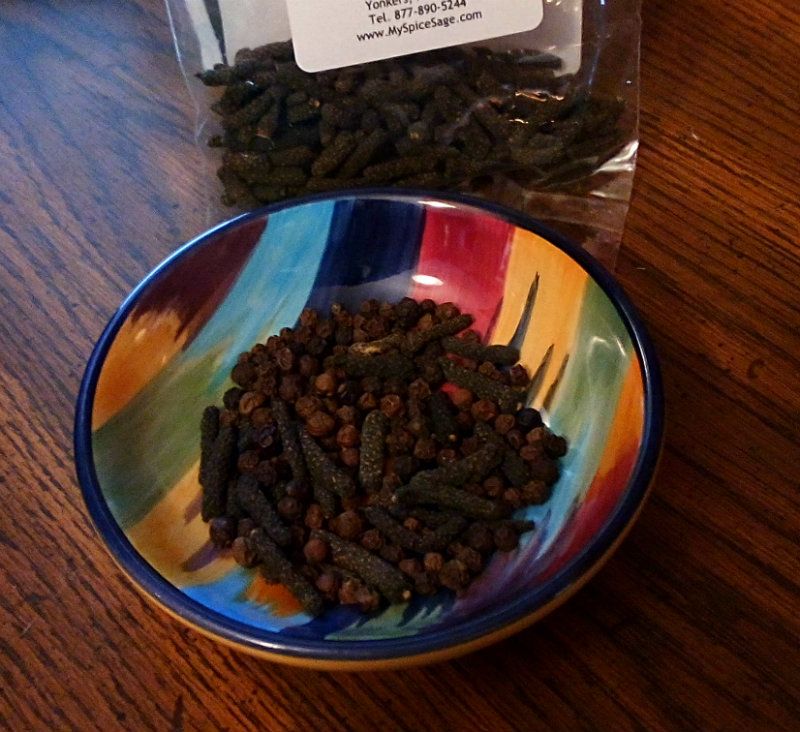 These were added 15 minutes into the boil. Here are the grains of paradise, coriander seed and allspice berries:  I added them, along with the lemon peel, with 10 minutes left in the boil. Finally, here are the mugwort and the elderflowers: 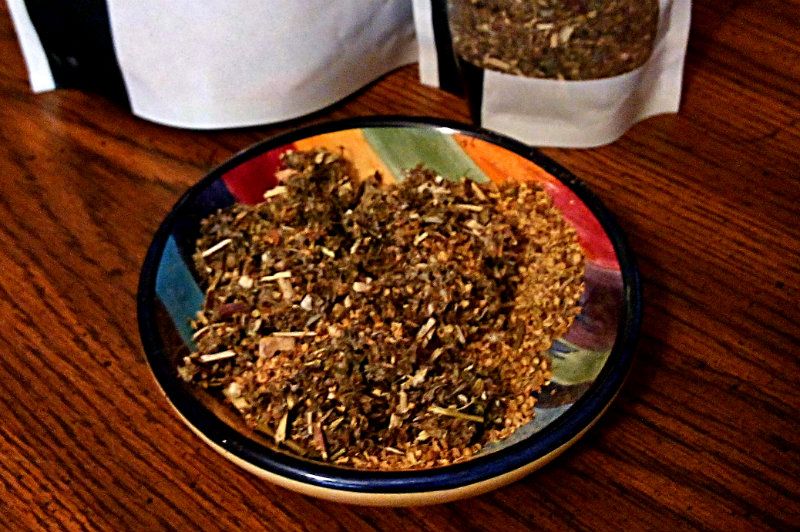 These were added with 5 minutes left in the boil. The boil went well enough; I was a a couple of minutes late with one addition, but extended the boil time by the same amount to compensate. Once again, no big deal in the over-all scheme of things. Once the boil was finished, I chilled the wort in an ice bath, transferred it to my fermenter and pitched my yeast. This Medieval concoction is now tucked safely away in my closet, there to begin it's fermentation in the neighbourhood of 68 degrees. I snatched a wee sample of the wort, and it is interesting for sure. There's almost no bitterness, but there is a little, and the spices seem to come through very well - it's subtle, not over-powering, and adds a little something that is unexpected and just simply nice. Time will tell, once fermentation is complete and the gruit has been bottled, but I think this might turn out to be very interesting, and tasty. More as it happens, etc. &c.... | ||
|
| one of us |
Yes very interesting ! I was thinking of dandelion wine which is usually made with an overpowering amount of orange and lemon. Your beer should be very different . With lemons in cooking we normally are told not to include the pith. But of course you're interested in counter-acting the malt. Let us know how it turns out ! | |||
|
| one of us |
Exactly - I think that it's working well, too... time will tell! Here is a label that I put together for this gruit - 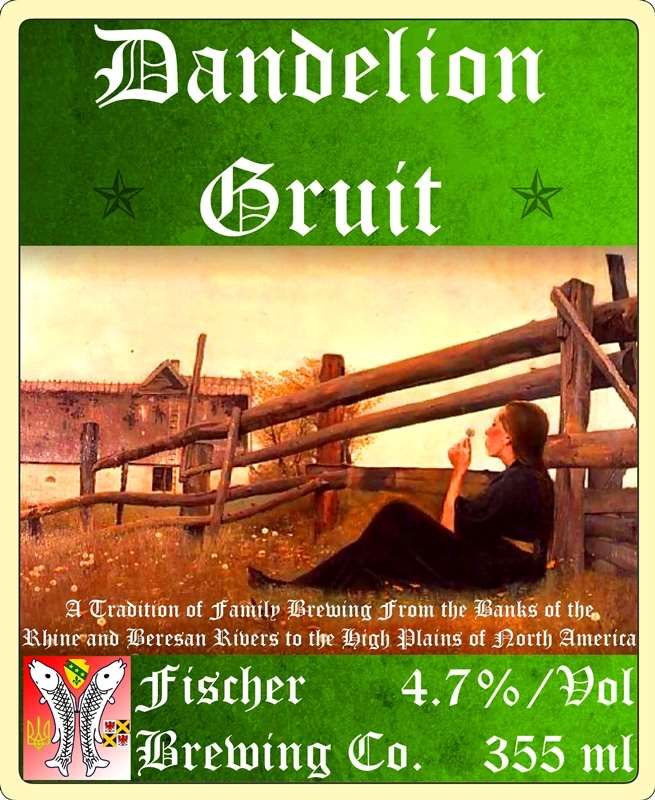 I usually allow 3 weeks total for fermentation; we're about halfway through that time period now, and I expect to bottle this gruit the weekend after this one. I checked on it this morning and it is looking good; smelling good and hopefully turning into something really special. More as it happens, etc. &c.... Ron | |||
|
| one of us |
Last night, 8 June, I put this brew in to cold-crash. I'll bottle it sometime this weekend. It looked and smelled pretty good, so we'll see what we end up with! | |||
|
| one of us |
I bottled my Dandelion Gruit today, 12 June. For this 1-gallon batch, I got 9 bottles, which seems to be about the norm. I had just enough left over for a small sample, and I was eager to see how this ancient beer with no hops would taste. Keeping in mind that this is not the final flavour of the gruit (time in the bottle dies change it, as it carbonates, develops and matures), I was both sirprised and a little pleased with what I had. The gruit definitely had a fresh, tart aspect to it; almost a sourness, but in a lemony way that is to be expected, due to the ingredients used. The extra spices that I added did not seem very prevalent, but I am guessing that they will come forward over time. I did smell the spices in the beer, but they were subtle. The dandelion leaves were also subtle, but I am guessing that they will come forward as the gruit develops. Conclusion: So far, is certainly different, and decidedly refreshing. It just might be the thing for a hot summer day - we'll see in a couple of weeks! | |||
|
| one of us |
I bottled my Dandelion Gruit today, 12 June. For this 1-gallon batch, I got 9 bottles, which seems to be about the norm. I had just enough left over for a small sample, and I was eager to see how this ancient beer with no hops would taste. Keeping in mind that this is not the final flavour of the gruit (time in the bottle does change it, as it carbonates, develops and matures), I was both surprised and a little pleased with what I had. The gruit definitely had a fresh, tart aspect to it; almost a sourness, but in a lemony way that is to be expected, due to the ingredients used. The extra spices that I added did not seem very prevalent, but I am guessing that they will come forward over time. I did smell the spices in the beer, but they were subtle. The dandelion leaves were also subtle, but I am guessing that they will come forward as the gruit develops. Conclusion: So far, it is certainly different, and decidedly refreshing. It just might be the thing for a hot summer day - we'll see in a couple of weeks! | |||
|
| one of us |
Well, I was able to sample this on Sunday, 26 June. It is still very, very young, but it was interesting and different, in a good way. The bottom line is that this is very much something that a person could enjoy on a hot, sunny summer day after mowing the lawn or perhaps out at the lake, which I believe is the intent of the recipe. I'll post more details as I can - this sampling was a bit rushed, so I'm just putting down general impressions here. There wasn't much of a head, and it didn't last long; perhaps the lack of hops might have something to do with this? Carbonation was quite lively - making this a fairly effervescent beverage. I think it was fairly clear, with a slight haze, but don't hold me to that until my next sampling. Aroma was a little strange, but not unpleasant. Perhaps herby, grassy and definitely lemony. If there was any spice in the aroma, it was very subtle, but there may have been a bare whiff there. The taste was something that really made this memorable. In spite of having only a single lemon peel in the entire gallon of beer, this gruit was very lemony, to the point of being almost sour. I liked it for what it was, but it is definitely something that one wouldn't expect. I recall while brewing this beer that the mash itself had a slight lemony quality; the only two grains are Belgian Pilsner and White Wheat, so one of them must have a bit of a citrusy characteristic. In any case, this was amplified quite a bit by the lemon peel. I expected some bitterness, both from the lemon peel and the dandelion leaves, but there really wasn't much. It is there but only in a very subtle way. Most - if not nearly all - of the balance against the sweet malts comes from the sourness of the lemon. The spices that I added were present, but very subtly and in the back - coming through just a bit in the finish. I am not sure how this gruit will develop as it ages, but I am interested in finding out. I am guessing that the spices might come forward a bit more, but I don't know whether or not the lemon will back off. Even if it doesn't, I think this is a pretty good thing. Once the "shock" of the lemon wears off after the first sip, this gruit is kind of addicting. I have always been a fan of Mike's hard lemonade; but this, in my opinion, has much more character and is far more...genuine. I also got to thinking that a shot of raspberry, strawberry or (fill in the blank) syrup might be an interesting addition to this; sort of like adding a shot of woodruff to a Berlinner Weisse. It would have the effect of balancing out the sour from the lemon, but would also add a touch of summer sunshine, as with flavoured lemonades. I'll probably give it a try with chokecherry, raspberry or possibly bullberry (aka buffaloberry) syrup, since those are the home-made syrups that I have on hand. All-in-all, a it is a good summer experience, and I could easily see myself brewing more for next year. If someone keeps in mind the original purpose of this gruit, and why it is the way it is, I think they could really enjoy it, either as per the original recipe, or with my slight modifications. As noted above, I do have the recipe, so if anyone is brave enough to try this, shoot a PM to me and I will get it to you. I'll post more impressions on this gruit as I sample more in the future, and might also try to get a photo of the finished beer, as well. | |||
|
| Powered by Social Strata |
| Please Wait. Your request is being processed... |
|
 The Accurate Reloading Forums
The Accurate Reloading Forums  THE ACCURATE RELOADING.COM FORUMS
THE ACCURATE RELOADING.COM FORUMS  Other Topics
Other Topics  Recipes for Hunters
Recipes for Hunters  Brooklyn Brewshop's Dandelion Gruit
Brooklyn Brewshop's Dandelion Gruit

Visit our on-line store for AR Memorabilia

